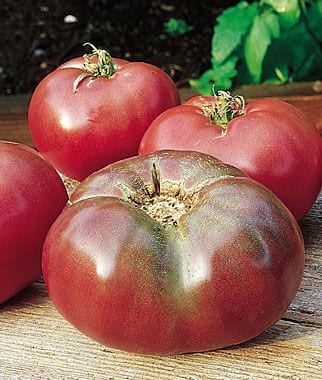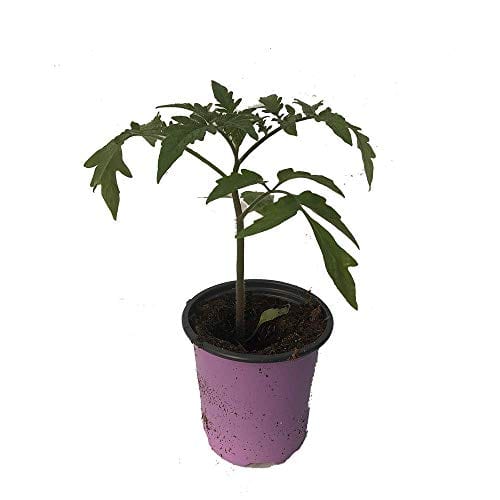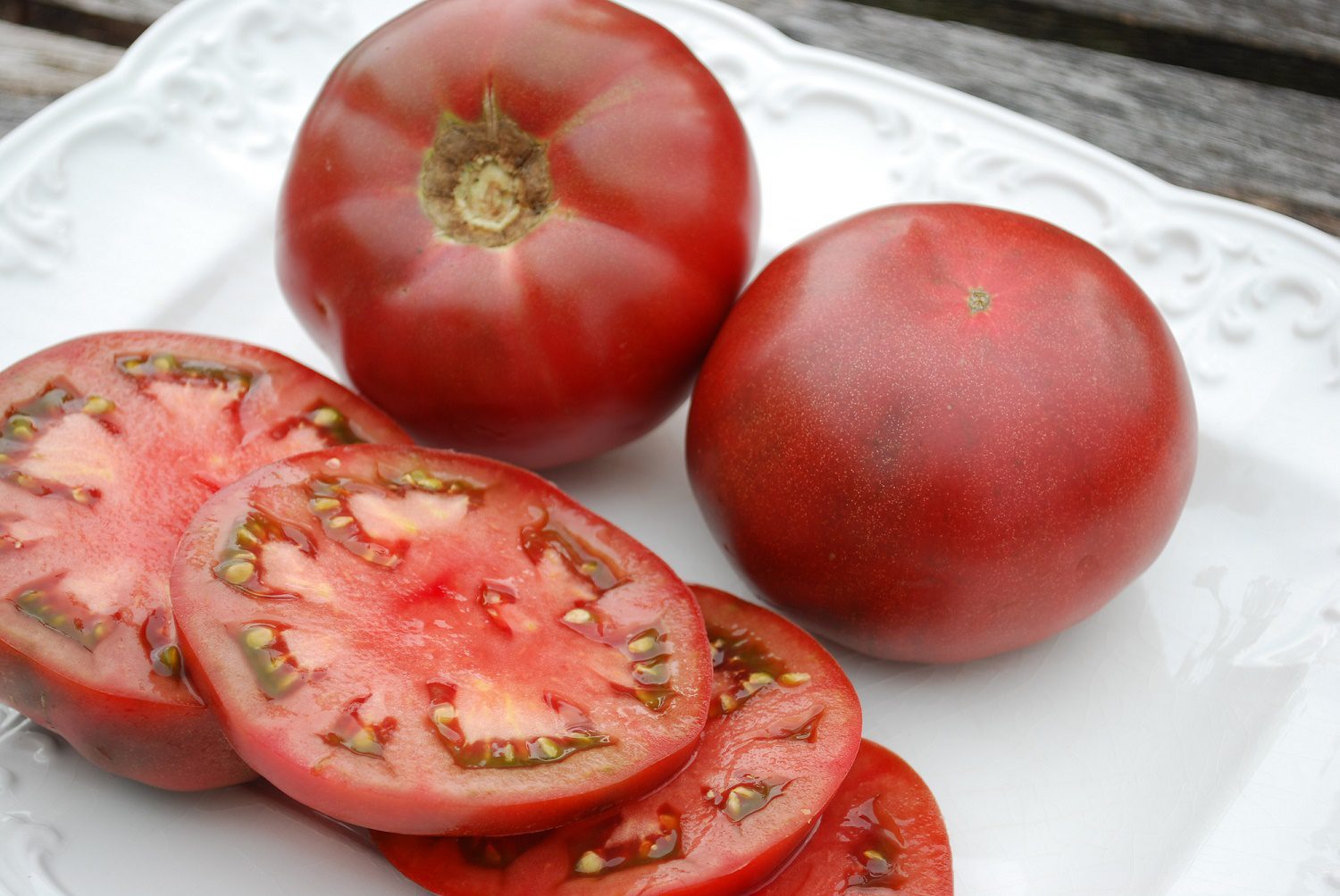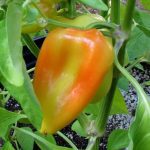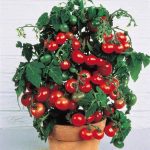Tomato, Cherokee Purple
Price range: $0.89 through $7.99
Discount per quantity
| Quantity | 3 - 8 | 9 - 14 | 15+ |
|---|---|---|---|
| Price | Price range: $0.86 through $7.75 | Price range: $0.84 through $7.51 | Price range: $0.80 through $7.19 |
| % Discount | 3% | 6% | 10% |
Description
Tomato ‘Cherokee Purple’: Heirloom Flavor, Dusky Color, Big Slices
Why We Love ‘Cherokee Purple’
We all want a tomato that tastes like summer. ‘Cherokee Purple’ delivers that and more. The skin is dusky rose with green shoulders. The flesh is deep red with a hint of plum. Slice it and you’ll see marbling that looks like a sunset. It’s beautiful on the plate. It’s even better on the tongue.
The flavor is famous. Rich. Sweet. Savory. A little smoky at the finish. In other words, it tastes like a real tomato should. It makes a simple sandwich feel special. It turns a salad into a main event. One thick slice can cover a burger. That’s the joy of a true heirloom slicer.
This variety is open-pollinated and indeterminate. Plants keep growing and setting fruit until frost. You get a steady stream of big tomatoes over many weeks. Each fruit usually weighs 10–12 ounces, with some reaching a full pound. The texture is tender and juicy without falling apart. The seed cavities are small, so each slice is mostly rich flesh.
‘Cherokee Purple’ has a story, too. Gardeners passed it along for generations because it tasted best. It became a favorite across the country after more than a few seed swaps. You feel that history with every harvest. It connects us to the people who grew it before us.
Performance is strong in warm weather. Plants love full sun, good soil, and steady moisture. They handle heat with grace when roots are mulched. They keep blooming through long days. Give them support and they reward you with big, handsome fruit. That’s why so many growers plant it every single year.
Quick highlights
- Type: Heirloom, open-pollinated, beefsteak-style slicer
- Growth: Indeterminate vine; keeps producing to frost
- Days to maturity: About 80–85 from transplant
- Fruit size: 10–12 oz typical; up to 1 lb on strong plants
- Color: Dusky rose to purple with green shoulders; deep brick-red flesh
- Flavor: Complex, sweet-savory, slightly smoky
- Use: Slicing, caprese, BLTs, salads, grilling, fresh sauces
- Sun: Full sun (6–8+ hours)
- Spacing: 24–36 inches with sturdy support
- Soil & water: Rich, well-drained soil; deep, regular watering
- Season: Warm-season annual; harvest midsummer to frost
What you’ll receive
Available as premium seed or as a strong, garden-ready transplant (seasonal). Our transplants are well-rooted in nursery pots so you can plant the day they arrive. Seeds are fresh and true to type for reliable germination and classic heirloom flavor.
Planting & Care Made Simple
Success starts with warmth, light, and support. ‘Cherokee Purple’ loves sun and steady care. The routine is easy once you set it up.
Timing & site
Plant outdoors after all danger of frost. Night temps should stay above 55°F and soil should feel warm to the touch. Choose the sunniest spot you have. Six to eight hours is good. More is even better. Rotate tomatoes to fresh ground each year when you can. This keeps soils balanced and plants happier.
Soil prep
Tomatoes want deep, fertile, well-drained soil. Mix in compost before planting. A handful of organic tomato fertilizer at the root zone is a smart start. If your ground is heavy clay, raise the bed or add coarse materials for better drainage. Good soil gives you strong vines and fewer problems later.
Planting depth
Set transplants deep. Strip the lower leaves and bury the stem up to the next set of leaves. Tomatoes can grow roots along buried stems. Deeper roots mean better drought tolerance and steadier growth. Firm the soil and water in well.
Support matters
Big fruit needs strong support. Use a tall cage, sturdy stakes, or a trellis. Tie stems loosely with soft ties as they grow. Keep the main stems lifted and open. This simple step improves airflow, reduces disease pressure, and holds heavy clusters off the ground. It also makes harvest fast and clean.
Watering rhythm
Think deep and even. Water at the base, not over the leaves. Aim for a slow soak that reaches the root zone. Let the top inch of soil dry before watering again. Mulch with straw or shredded leaves to keep moisture steady and prevent splash on leaves. Consistent moisture helps prevent cracking and blossom-end rot. Avoid big swings between very dry and very wet.
Feeding
Feed lightly but regularly. Start with a balanced organic fertilizer at planting. Switch to a bloom-supporting feed once flowers appear. Too much nitrogen makes lots of leaves and fewer tomatoes. We want fruit, so we keep feeding balanced and steady. A monthly top-dress of compost around the drip line is an easy, gentle boost.
Pruning (keep it simple)
‘Cherokee Purple’ is vigorous. You can prune or not, depending on your style. For tidier vines and larger fruit, train one or two main stems. Pinch the lowest suckers and any shoots that crowd the center. Always remove leaves that touch the soil. In humid regions, thinning a bit for airflow helps a lot. In dry regions, a fuller plant can shade fruit from sunscald. Choose what fits your climate and schedule.
Common issues & easy fixes
- Cracking: Usually from uneven watering or sudden rain after a dry spell. Mulch and steady moisture prevent it.
- Blossom-end rot: A watering consistency issue more than a calcium shortage. Keep soil moisture even and avoid root stress.
- Early blight/Septoria: Improve airflow, mulch the soil, and water at the base. Remove the lowest leaves as the plant grows.
- Sunscald: In extreme heat, keep some leaf cover over fruit. Light pruning only.
- Catfacing (misshapen fruit early): Common in cool, early blooms. Later fruit usually sets smooth and full.
Container growing
No ground? No problem. Plant one vine in a 20+ gallon container with drainage. Use a high-quality potting mix. Add a tall cage at planting time. Water more often than in the ground and feed lightly every 2–3 weeks once blooming starts. Big pot, big support, big harvest.
Pollinators & companions
Tomatoes are self-fertile but love a little motion. A gentle shake of the cage on calm mornings helps move pollen. Companion plant with basil, marigold, dill, or nasturtium to draw helpful insects and add beauty. Keep tall, thirsty neighbors a few feet away so tomatoes get the sun and water they need.
Season care checklist
- Plant deep in warm soil and full sun
- Cage or stake early; tie stems as they grow
- Water deep and even; mulch to hold moisture
- Feed modestly; focus on fruit, not just leaves
- Remove low leaves; keep good airflow
- Harvest often and celebrate every slice
Harvest, Flavor, and Kitchen Joy
Harvest when the skin turns dusky rose with a soft give to the touch. The shoulders may keep a hint of green even when the fruit is ripe. That’s normal for this variety. Pick gently and set the fruit stem-side down on the counter. Never refrigerate fresh heirlooms unless they are already sliced. Cold dulls the flavor.
If storms threaten or a hungry critter lurks, pick at the “breaker” stage—a blush of color just starting. Let the fruit finish on the counter out of direct sun. The taste stays full and sweet. Handle ripe fruit with care. Heirlooms are tender because they are juicy. That’s the point. That juice is where the magic lives.
Kitchen uses we love
- Legendary sandwiches: One thick slice, toasted bread, a swipe of mayo, a little salt. Done.
- Caprese with character: Layer ‘Cherokee Purple’ with mozzarella and basil. The color contrast is stunning.
- Grilled slabs: Brush slices with olive oil and grill for a minute per side. Add herbs, and the sugars caramelize.
- Fresh sauces: Chop, warm briefly with garlic and olive oil, toss with pasta. Bright and bold.
- Platters & boards: Wedges with burrata, olives, and grilled bread make a simple summer supper.
The flavor is complex yet friendly. It plays well with basil, chives, parsley, and thyme. It loves olive oil, balsamic, lemon, and a little sea salt. It pairs with burrata, feta, or a sharp cheddar. It holds its own next to grilled steak or smoky eggplant. Every plate looks special because the color reads like a rare gem.
Storing and savoring
Keep ripe tomatoes at room temperature. Eat within a few days for peak flavor. If you need to hold them, choose the coolest counter spot you have. Bruised fruit? Turn it into salsa or a quick pan sauce the same day. Nothing goes to waste in tomato season.
Saving seed
Because ‘Cherokee Purple’ is open-pollinated, you can save seed from your best fruit. Let a prime tomato fully ripen. Scoop seeds with gel, ferment in a jar with a little water for a few days, rinse, and dry on a plate. Store when fully dry. Next year, you plant a taste of your own garden’s story.
Design & display
In beds, place one or two vines where you pass each day. You see color changes and never miss perfect ripeness. Edge the bed with basil. Tuck marigolds at the corners. Add a trellis that looks handsome even in winter. Your tomato row becomes a focal point. It looks intentional and it works hard.
Why this variety belongs with us
We pick crops that make you proud to serve simple food. ‘Cherokee Purple’ does that. The fruit is big and generous. The flavor is deep and memorable. The plant is productive and steady with basic care. Instead of chasing new names each year, we can trust a classic that keeps its promise. Plant it once and you’ll want it again.
Specs at a glance
- Botanical name: Solanum lycopersicum ‘Cherokee Purple’
- Category: Heirloom, indeterminate, beefsteak-type
- Height: 5–7 ft with support
- Spacing: 24–36 in between plants; 3–5 ft between rows
- Maturity: ~80–85 days from transplant
- Fruit: 10–12 oz, meaty, multi-locular with small seed pockets
- Skin/Flesh: Dusky rose skin; brick-red to purple flesh
- Taste profile: Sweet-savory, rich, slightly smoky
- Best for: Slicing, salads, fresh eating, light cooking
Bring ‘Cherokee Purple’ into your garden and your kitchen will glow all season. Plant it deep. Keep it even. Support it well. Harvest often. Share the extras. That rhythm feels good and tastes even better.
Dusky Slices, Big Smiles—Let’s Grow This Legend Together
Additional information
| Weight | N/A |
|---|---|
| Options | Seed 10 count, 3.5 in. (12.3 fl. oz.) Pot |

